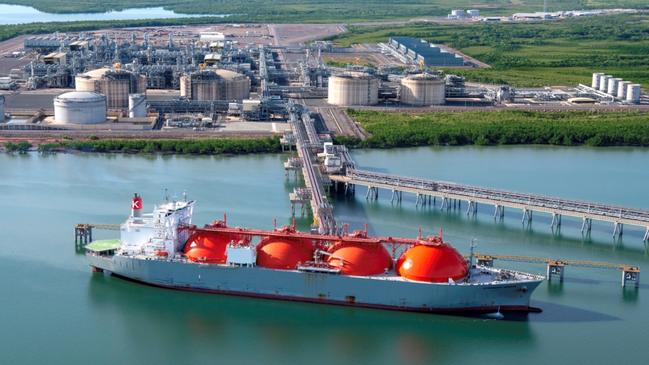Surging LNG prices fails to boost Santos, Origin Energy, Woodside shares
Shares of global companies leveraged to LNG have surged. Not so in Australia, where major producers have underperformed despite a record $48bn in the nation’s exports.

The nation’s natural gas exports surged to a record $48bn in revenues but the United States is expected to overtake Australia as the world’s largest exporter this year.
Despite the increase in local revenues, according to preliminary EnergyQuest data, the share price of the country’s largest LNG producers — Santos, Woodside and Origin Energy — failed to keep pace with their global peers.
Preliminary data for the 2021 calendar year released by EnergyQuest indicates that, based on shipping data, Australian LNG exports hit a new record of 80.9 million tonnes in 2021, up 3.7 per cent year on year.
While the volume was up slightly, revenue surged 25 per cent from $36bn to $48bn.
“The massive increase in export revenue takes Australia back to the record level achieved in 2019 prior to the pandemic,’’ EnergyQuest chief executive Graeme Bethune writes.
But that surge has not been reflected in the share prices of Santos, Woodside and Origin Energy, with Santos flat over the year, Woodside down 3.6 per cent, and Origin, up, but by “only” 10.1 per cent, Dr Bethune said.
Data sourced from the ASX on Tuesday shows the energy sector on the whole has badly lagged the broader sharemarket over the past 12 months, dropping by 0.98 per cent, while the ASX 200 delivered a 13.02 per cent return over the year.
In comparison nine of the 11 sectors tracked by the ASX had delivered gains over the past 12 months, with telecommunications services up 27.3 per cent, Australian real estate investment trusts up 20.7 per cent and consumer discretionary up 20.1 per cent.
Only information technology performed worse than energy, falling 2.62 per cent.

Dr Bethune said globally, the share price performance of companies leveraged to LNG was much better, with Shell and Chevron, which are also Australia’s largest LNG producers, up by more than 30 per cent in 2021, and US producer Cheniere up 69 per cent.
Dr Bethune said the performance of Australian energy shares was “a bit of a conundrum” and could motivate more merger and acquisition activity, possibly including international players, in the short term.
“For the year the S&P 500 Energy Index (in the US) was up by 48 per cent, outperforming the S&P Clean Energy Index which was down by 24 per cent,’’ he said.
“Investment in traditional energy is far from dead globally, but it appears to be in the Australian share market.’’
Dr Bethune said based on volume, Australia was likely to again rank as the world’s largest LNG exporter, but that was likely to change this year.
“Australia’s 10 LNG projects have total production capacity of 89 million tonnes per annum (Mtpa), the world’s largest,’’ he said.
“The other major global producer, Qatar, which does not release timely export statistics, currently has lower total capacity of 77Mtpa.
“However, Australia’s ranking is under threat from Qatar and also the USA. Qatar plans to expand its capacity to 110Mtpa by 2026.
“New LNG expansion in the US is likely to see Australia lose its top producer ranking in 2022, according to the US Energy Information Agency.
“This will be an increasing challenge for Australian LNG producers wanting to contract new projects, or extend existing operations.’’
Dr Bethune said it was likely that 2021 could represent the peak of Australia’s LNG production.
“The biggest threats are not only increasing competition but also the natural decline in the gas fields feeding existing projects and the limited number of new projects,’’ he said.
While two new projects were announced last year, Santos’s Barossa project to backfill Darwin LNG and the Woodside Scarborough project, Dr Bethune said the best case scenario is that these simply bring production back to about current levels.
“They are unlikely to take it up to new levels. Reaching new levels would require new sources of gas to turn around the decline in the North West Shelf, Australia’s largest LNG project.’’
Dr Bethune said China replaced Japan as Australia’s largest LNG buyer in 2021, replacing Japan, and representing 39.5 per cent of export sales.
“Growing LNG sales to China reflect the rapid growth in Chinese natural gas demand as the economy has recovered from the pandemic and also the push to reduce air pollution in major cities,’’ he said,
“LNG deliveries also grew to Korea and Taiwan. However, deliveries to Japan were down 9.3 per cent on 2020, largely due to the expiry of Japanese contracts with the North West Shelf and Darwin LNG.’’


To join the conversation, please log in. Don't have an account? Register
Join the conversation, you are commenting as Logout